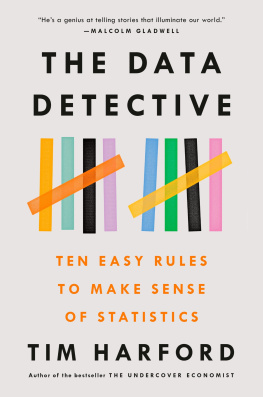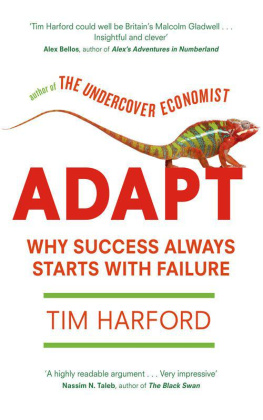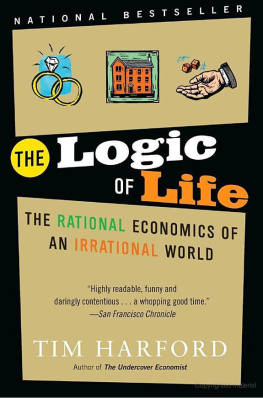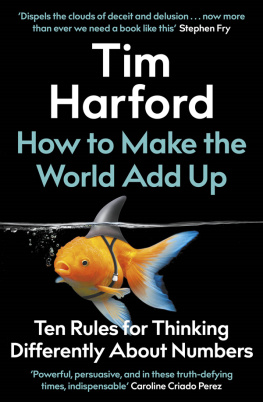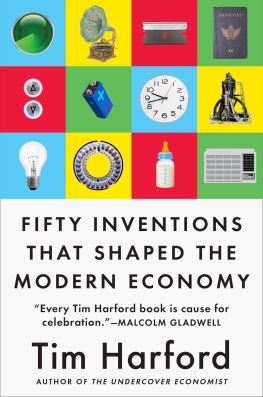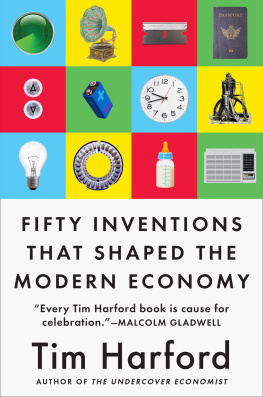The Undercover Economist
The Logic of Life
Dear Undercover Economist
Adapt
The Undercover Economist Strikes Back
Published by Little, Brown
ISBN: 978-1-4087-0677-0
Copyright 2016 Tim Harford
The moral right of the author has been asserted.
All rights reserved. No part of this publication may be reproduced, stored in a retrieval system, or transmitted, in any form or by any means, without the prior permission in writing of the publisher.
The publisher is not responsible for websites (or their content) that are not owned by the publisher.
Little, Brown
Little, Brown Book Group
Carmelite House
50 Victoria Embankment
London EC4Y 0DZ
www.littlebrown.co.uk
www.hachette.co.uk
To Stella, Africa and Herbie masters of mess
Contents
It was unplayable.
On the 27th of January 1975, a seventeen-year-old German named Vera Brandes stepped out on to the vast stage of the Cologne Opera House. The auditorium was empty and lit only by the dim green glow of the emergency exit sign, but this was the most exciting day of Veras life. She was the youngest concert promoter in Germany and she had persuaded the Opera House to host a late-night concert of improvised jazz by the American pianist Keith Jarrett. and in just a few hours, Jarrett would stride out in front of 1400 people, sit down at the Bsendorfer piano and, without sheet music or rehearsal, begin to play.
But that afternoon, Vera Brandes was introducing Keith Jarrett and his producer Manfred Eicher to the piano and it wasnt going well.
recalls Brandes. Then Eicher played a few notes. They didnt say anything. They circled the instrument several times and then tried a few keys. Then after a long silence, Manfred came to me and said, If you dont get another piano, Keith cant play tonight.
Vera Brandes was stunned. She knew that Jarrett had requested a specific instrument and the Opera House had agreed to , that was completely out of tune, the black notes in the middle didnt work, the pedals stuck. It was unplayable.
Brandes tried everything to find a replacement. She even rounded up friends to push a grand piano through the streets of Cologne, but it was raining hard and the local piano tuner warned her that the substitute instrument would never survive the trip. Instead, he worked to fix up the little Bsendorfer that was on stage already. Yet he could do nothing about the muffled bass notes, the plinky high notes and the simple fact that the piano a small piano, like half a piano just didnt make a loud enough sound to reach the balconies of the vast auditorium.
Understandably, Jarrett didnt want to perform. He left and went to wait in his car, leaving Brandes to anticipate the arrival of 1400 soon-to-be-furious concert-goers. The best day of her life had suddenly become the worst; her enthusiasm for jazz and her precocious entrepreneurial spirit brought the prospect of utter humiliation. Desperate, she caught up with Jarrett and, through the window of his car, begged him to play. The young pianist looked out at the bedraggled German teenager standing in the rain and took pity on her. Never forget, Jarrett said. Only for you.
A few hours later, as midnight approached, Keith Jarrett walked out to the unplayable piano in front of a packed concert hall, and began.
The minute he played the first note, everybody knew this was magic, recalls Brandes.
That nights performance began with a simple chiming series of notes, then quickly gained complexity as it moved by turns between dynamism and a languid, soothing tone. It was beautiful and strange, and it is enormously popular: The Kln Concert album has sold 3.5 million copies. No other solo jazz album nor solo piano album has matched that.
When we see skilled performers succeeding in difficult circumstances, we habitually describe them as having triumphed over adversity or despite the odds. But thats not always the right perspective. Jarrett didnt produce a good concert in trying times. He produced the performance of a lifetime, but the shortcomings of the piano actually helped him.
The substandard instrument forced Jarrett away from the tinny high notes and into the middle register. His left hand produced rumbling, repetitive bass riffs as a way of covering up the pianos lack of resonance. Both of these elements gave the performance an almost trance-like quality. That might have faded into wallpaper music, but Jarrett couldnt drop anchor in such a comfortable musical harbour, because the .
Whats important to understand is the proportion between the instrument and the magnitude of the hall, recalls Vera Brandes. Jarrett really had to play that piano very hard to get enough volume to get to the balconies. He was really pchow pushing the notes down.
Standing up, sitting down, moaning, writhing, Keith Jarrett didnt hold back in any way as he pummelled the unplayable piano to produce something unique. It wasnt the music that he ever imagined playing. But handed a mess, Keith Jarrett embraced it, and soared.
Keith Jarretts instinct was not to play and its an instinct that most of us would share. We dont want to work with bad tools, especially when the stakes are so high. But with hindsight, Jarretts instinct was wrong. What if our own similar instincts are also wrong, and in a much wider range of situations?
The argument of this book is that we often succumb to the temptation of a tidy-minded approach when we would be better served by embracing a degree of mess. Keith Jarretts desire for a perfect piano was one example of this tidiness temptation. Others include the public speaker who cleaves to a script; the military commander who carefully strategises; the writer who blocks out distractions; the politician who sets quantifiable targets for public services; the boss who insists on tidy desks for all; the team leader who makes sure everyone gets along. We succumb to the tidiness temptation in our daily lives when we spend time archiving our emails, filling in questionnaires on dating websites that promise to find our perfect match, or taking our kids to the local playground instead of letting them run loose in the neighbourhood wasteland.
Sometimes, of course, our desire for tidiness our seemingly innate urge to create a world that is ordered, systematised, quantified, neatly structured into clear categories, planned, predictable is helpful. It wouldnt be such a deeply rooted instinct if it werent.
But often we are so seduced by the blandishments of tidiness that we fail to appreciate the virtues of the messy the untidy, unquantified, uncoordinated, improvised, imperfect, incoherent, crude, cluttered, random, ambiguous, vague, difficult, diverse or even dirty. The scripted speech misreads the energy of the room; the careful commander is disoriented by a more impetuous opponent; the writer is serendipitously inspired by a random distraction; the quantified targets create perverse incentives; the workers in the tidy office feel helpless and demotivated; a disruptive outsider aggravates the team but brings a fresh new insight. The worker with the messy inbox ultimately gets more done; we find a soulmate when we ignore the website questionnaires; the kids running loose in the wasteland not only have more fun and learn more skills, but also counterintuitively have fewer accidents.
And the pianist who says, Im sorry, Vera, that piano is simply unplayable, and drives off into the rainy Cologne night leaving a seventeen-year-old girl sobbing on the kerbside, never imagines that he has passed up the opportunity to make what would have been his most-loved piece of work.
I hope this book will serve as the Vera Brandes in your life the nudge, when you are tempted by tidiness, to embrace some mess instead. Each chapter explores a different aspect of messiness, showing how it can spur creativity, nurture resilience and generally bring out the best in us. That is true whether we are performing with a piano in front of a concert hall audience or a slide deck in front of a boardroom; whether we are running a corporation or manning a call centre; whether we are commanding an army, dating, or trying to be a good parent. The success we admire is often built on messy foundations even if those foundations are usually hidden away.
Next page

